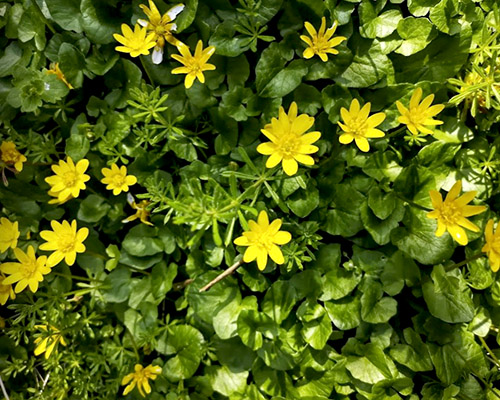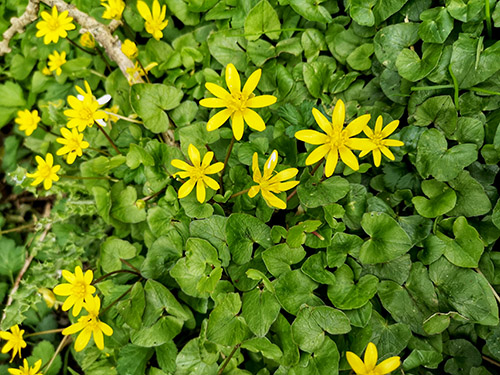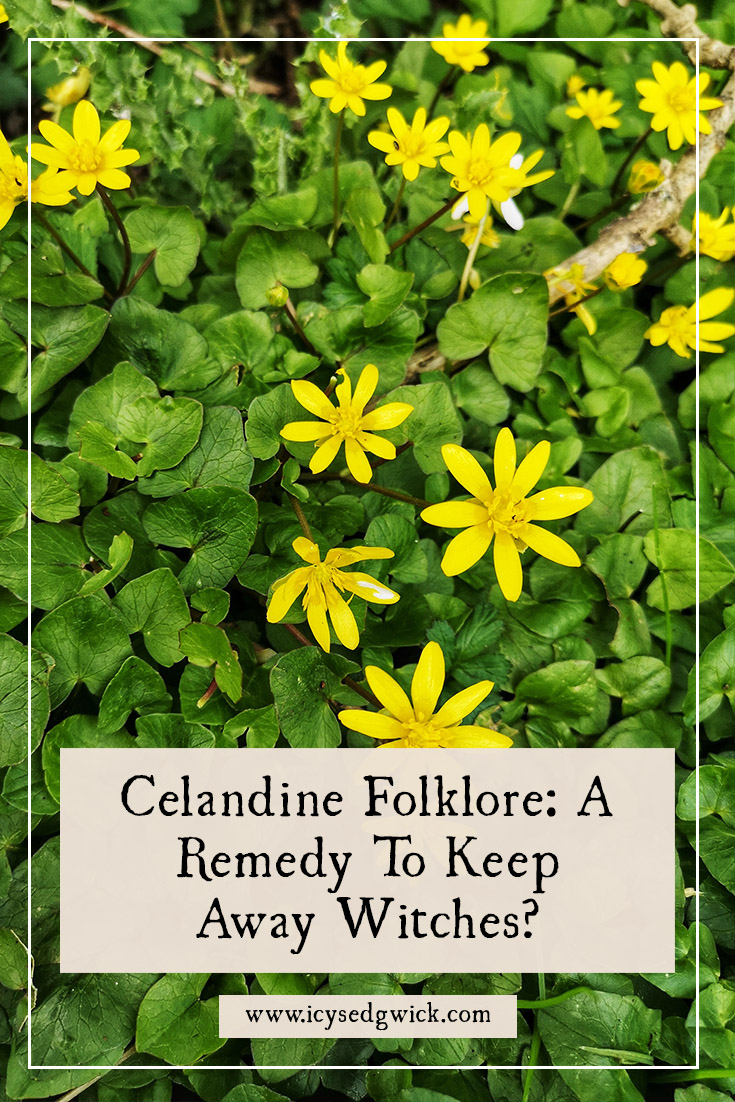Plants often become unwanted plants when they’re especially prolific. Celandine is one such plant, quickly spreading to fill an area with its glossy green leaves and dizzyingly bright yellow flowers.
But celandine is also a confusing plant, since the two varieties with the same name are unrelated. The greater celandine Chelidonium majus is a member of the poppy family, while the lesser celandine Ranunculus ficaria is in the buttercup family.
You can tell the two plants apart because Ranunculus ficaria flowers between January and April, while Chelidonium majus flowers between May and August. You often find the lesser variety in damp, shady woodland, while the greater variety likes grassland and garden borders.
This post is going to dive into the folklore and legends of both varieties, especially since there is some overlap! Remember, this post simply covers folklore and beliefs, so don’t try any of these remedies. This post does not provide medical advice.
If you’re interested in learning more about herbalism and how to make your own potions from what grows in your garden, I highly recommend the courses from Rowan + Sage. I’m currently working through Kitchen Herbcraft, and you can join me in class here!
Greater Celandine
Greater celandine is considered an invasive weed, although it does have its uses for pollinators in wildlife gardens. Since it flowers into late summer, it continues to provide a food source as late as October.
The Folklore
In folklore, greater celandine could cure depression and raise the spirits if worn (Dietz 2020: 56).
Witches might carry the plant in a red bag around their necks to avoid being detected or imprisoned. At the same time, if you scrubbed your floor with celandine-infused water, or burned the plant as incense, it drove witches away (Morton 2023).

It also had associations with legal matters, and wearing greater celandine against the skin could help you to avoid unwarranted imprisonment (Dietz 2020: 56). You just had to make sure you replaced it every three days.
People could also wear the plant to a court hearing to improve their prospects with the judge and jury (Dietz 2020: 56). These legal associations definitely seem stronger in the US.
Wartweed?
We talked last week about how dandelions could be used to remove warts. Greater celandine is also helpful for doing so. Lore directed people to pull up the plant at midnight. They should then bury it and dig it up three days later. Having dug up the plant, they could squeeze the juice over the wart (Binney 2018: 120).
This is perhaps more fiddly than another remedy, in which you cut either an apple or a potato in half, and then rubbed both pieces on the wart. Then you put the two halves back together, bound the whole apple or potato with string, and buried it. In this remedy, the wart would apparently disappear as the item rotted (Binney 2018: 120).

People called the plant wartweed, killwart, and wartflower due to the belief it could cure warts (Baker 2011 [1969]: 39). It is the bright sap from the stalk that seems to do the job. This sap, described by the Royal Horticultural Society as “orange latex” can be an irritant (2023b).
According to recollections on Plant-lore.com, lots of people believed greater celandine had wart-busting properties. One woman grew up on a farm and her father grew the plant specifically to treat warts and verrucas (2021a).
Eyesight Issues
Pliny, that friend of Fabulous Folklore, claimed celandine was also called swallow wort because swallows fed their babies the plant to improve their eyesight (Baker 2011 [1969]: 39). Elsewhere, he apparently believed swallows fed their babies celandine if their babies were blind.
Incidentally, those on Plant-lore.com reported that greater celandine helped with eye ailments. One respondent in 2012 said bathing the eyes with an infusion of the leaves and flowers could reduce cataracts. A respondent in 2004 said passing the juice from the leaves over the eyelids treated eye problems (2021a).

Old English medicinal tomes recommend warming an infusion of greater celandine with honey in a copper pot and using it as an eye salve (Morton 2023).
Pliny might not have been wholly wrong in calling the plant ‘swallow wort’, though the reasoning behind it was no doubt a bit iffy. Some say the swallows return when the celandine blooms, although this would place the return of the bird in February… which is the lesser celandine, not the greater celandine.
That said, the Greek word for swallow was ‘chelidon’, and ‘celandine’ is believed to be the anglicised form of ‘chelidon’. So that would certainly support the greater celandine as being swallow wort.
Curing Jaundice?
People believed the plant could cure jaundice, based on the doctrine of signatures. Because the flower was so yellow, it was believed to cure jaundice, which turns the skin yellow. I could find very little lore to back this up, so I’m not sure how widespread this belief was (Baker 2011 [1969]: 39).
Lesser Celandine
The lesser celandine appears in the spring and provides nectar for early pollinators. It’s got heart-shaped leaves and bright yellow flowers on long stalks. Where the greater celandine grows tall, the lesser celandine forms mats at ground level.
Some consider it a weed since it spreads quickly. It is a British native plant, and you often find it in woodland areas, or beside streams. In the US, the lesser celandine is classified as invasive in several states, and is toxic to grazing livestock (Morton 2023).
The young leaves are apparently edible for humans, sometimes used as salad leaves. Apparently, they’re high in vitamin C and people in Germany used them to treat scurvy (RHS 2023a). This might explain its alternative name of ‘scurvyherb’ (Dietz 2020: 183).
As always, don’t eat any plants you find unless you know 100% what you’re picking and how to prepare them.
William Wordsworth wrote the poems, ‘The Small Celandine’, ‘To the Same Flower’ and ‘To the Small Celandine’ about Ranunculus ficaria. They’re also the plant that covers the ground in all directions when spring returns to Narnia in The Lion, the Witch and the Wardrobe.
Folklore
People called the lesser celandine ‘goldy knob’, ‘golden guineas’, or ‘filding cup’ due to its bright yellow colour (Baker 2011 [1969]: 39). In the US, it’s sometimes referred to as the fig buttercup.
Children used celandines the same as buttercups, which is hardly surprising since they’re related. You held the flower under your chin, and if it reflected yellow on your skin, it meant you liked butter. I’m not sure why this was an important thing to divine with flowers, but it makes a change from the usual love divination on this blog.
Lesser celandine also had legal matters, joy, protection, and happiness as its symbolic meanings (Dietz 2020: 183). Much like dandelions, the flowers close before rain arrives, so people once tried to use them to predict the weather (Woodland Trust, n.d.).
Potential Remedies?
If greater celandine was ideal for treating warts, then lesser celandine had its own uses… its alternative name of ‘pilewort’ will give you a few clues as to what they were.
A Plant-lore.com respondent in 2004 suggested that cooking the corms of the plant with lard would help to cure piles. I’m assuming you applied the mixture to get the effects of it. Meanwhile, a respondent in 2001 said she’d heard of a friend’s father using the petals in lard to make an ointment (2021b). The man didn’t tell the respondent where he put the ointment, so we can only assume it was to cure piles.
This association between the plant and piles came from the doctrine of signatures. Since the root looked like a haemorrhoid, people assumed the plant could cure piles (Morton 2023).
What do we make of celandine?
Despite being in two different plant families, celandines look somewhat similar in colour and flower shape. Yet it seems our forebears didn’t confuse it, since the lore is quite specific about the uses of each plant. Rather, it seems to be more recent books that lump both types of plant together and then mix them up… where I’ve tried to keep them separate!
It’s fascinating that both plants appear as remedies before anything else, although Chelidonium majus‘s use to ward off witches or win legal battles gives it the folklore edge. Neither plant possesses much lore in the way of divination, suggesting this was a plant used medicinally, rather than magically.
They also both have their uses for pollinators, but their prolific growth can make them a nightmare for gardeners. Luckily, they also thrive in wild areas, where they can at least continue to feed bees and other insects.
Do you know any other folklore about these plants? Let me know below!
References
Morton, Ian (2023), ‘Celandine: The delicate flower, harbinger of spring, which Wordsworth thought more beautiful than daffodils’, Country Life, https://www.countrylife.co.uk/nature/celandine-the-delicate-flower-harbinger-of-spring-which-wordsworth-thought-more-beautiful-than-daffodils-212412.
Plant-lore.com (2021a), ‘Greater Celandine’, Plant-lore.com, https://www.plant-lore.com/greater-celandine/.
Plant-lore.com (2021b), ‘Lesser Celandine’, Plant-lore.com, https://www.plant-lore.com/lesser-celandine/.
RHS (2023a), ‘Celandine’, Royal Horticultural Society, https://www.rhs.org.uk/weeds/celandine.
RHS (2023b), ‘Greater celandine’, Royal Horticultural Society, https://www.rhs.org.uk/weeds/greater-celandine.
Woodland Trust (no date), ‘Lesser Celandine’, Woodland Trust, https://www.woodlandtrust.org.uk/trees-woods-and-wildlife/plants/wild-flowers/lesser-celandine/.
Nutty about folklore and want more?
Add your email below and get these posts in your inbox every week.
You'll also get my 5-step guide to protecting your home using folklore!











Have your say!